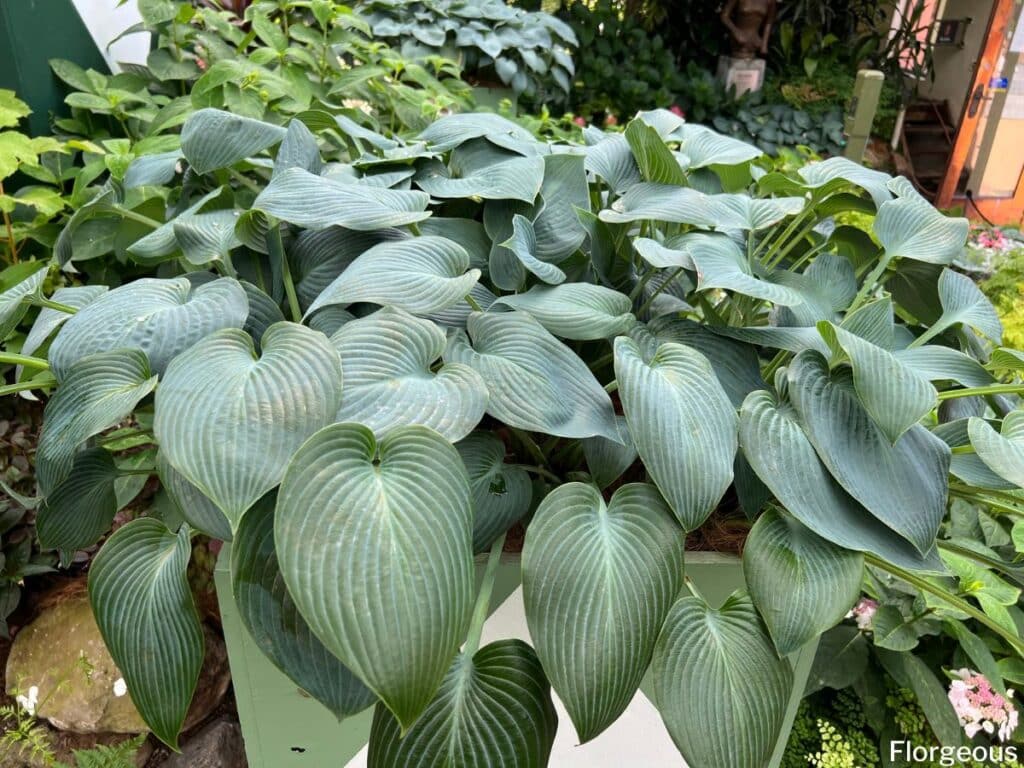Hosta plants (Hosta), also known as plantain lilies, are probably some of the most popular plants for shade garden spaces because they flourish in these low light conditions and can add lots of texture, color, and vibrancy to your landscape.
These evergreen plants are also useful as shade ground cover plants and they can be very useful as garden fillers or for creating a garden border.
There are over 70 species of hostas with 3,000 different registered cultivars that all can grow well in partial shade and can be paired or combined for a vibrant garden. But the very best way to add more color and texture to your shade garden is by pairing hostas with companion plants that can complement these leafy plants.
In this guide, we are going to take a look at some of the best hostas companion plants to include if you want to add a bit of diversity to your hosta garden.
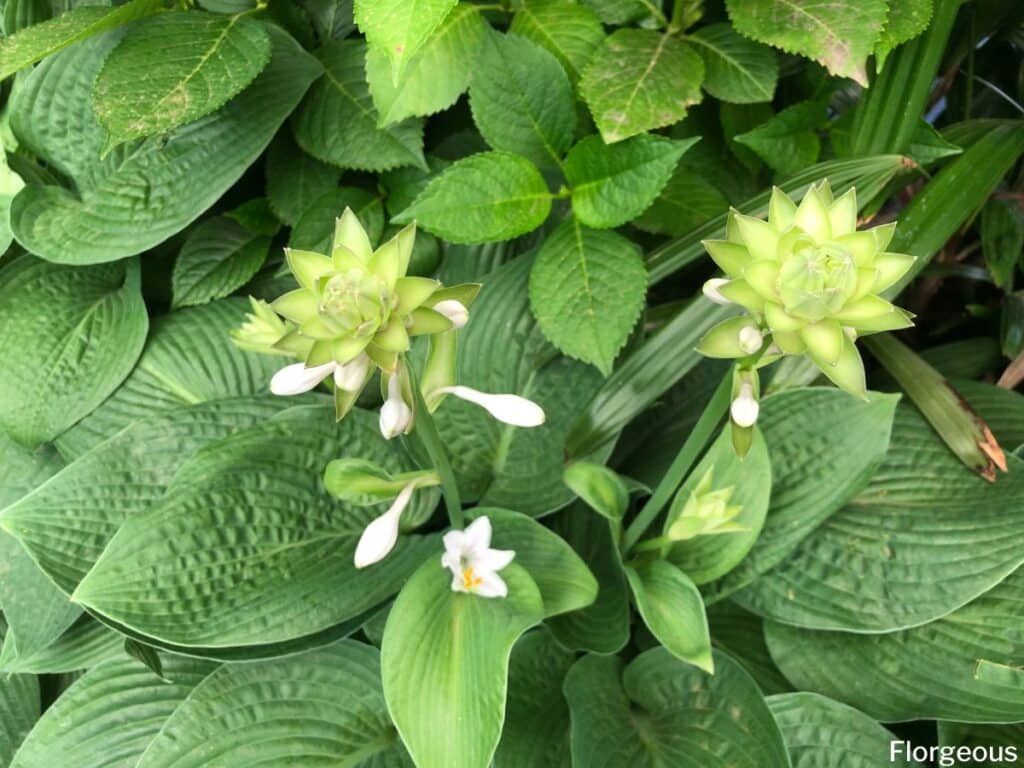
What to Plant with Hostas
Hostas are low-maintenance plants that get along well with a huge variety of plant species. If you want to maintain a low-maintenance garden then it is best to pair these evergreen plants with other plants that have similar growing conditions.
Hostas will flourish in moist soil and partial shade. The light or yellow-leaved cultivars do prefer a little bit of sun and there are quite a few varieties that do tolerate some sun.
But on a whole, these plants prefer shade gardens and they need to be established in well-draining fertile soil that is watered regularly.
Once you know how to care for hostas, adding companions will be the next thing to do.
Here is a quick look at some other interesting plants that grow well in these same conditions.
Japanese Forest Grass
Golden Japanese forest grass (Hakonechloa macra) is a superb companion plant for hostas because the thin tall leaves will add lots of texture to your garden bed and the light colorful foliage will create lots of contrast amongst the dark green foliage of the hostas.
Japanese forest grass will grow well in partial shade or even full sun in colder climates. The grass needs to be established in humus-rich well-drained soil and it should be kept moist at all times.
These types of ornamental grasses should be established amongst your hostas. During spring and summer, it will add lots of texture and color and the hostas will keep the garden bed full during the colder months when these grasses lose their leaves and die back.
Hydrangea
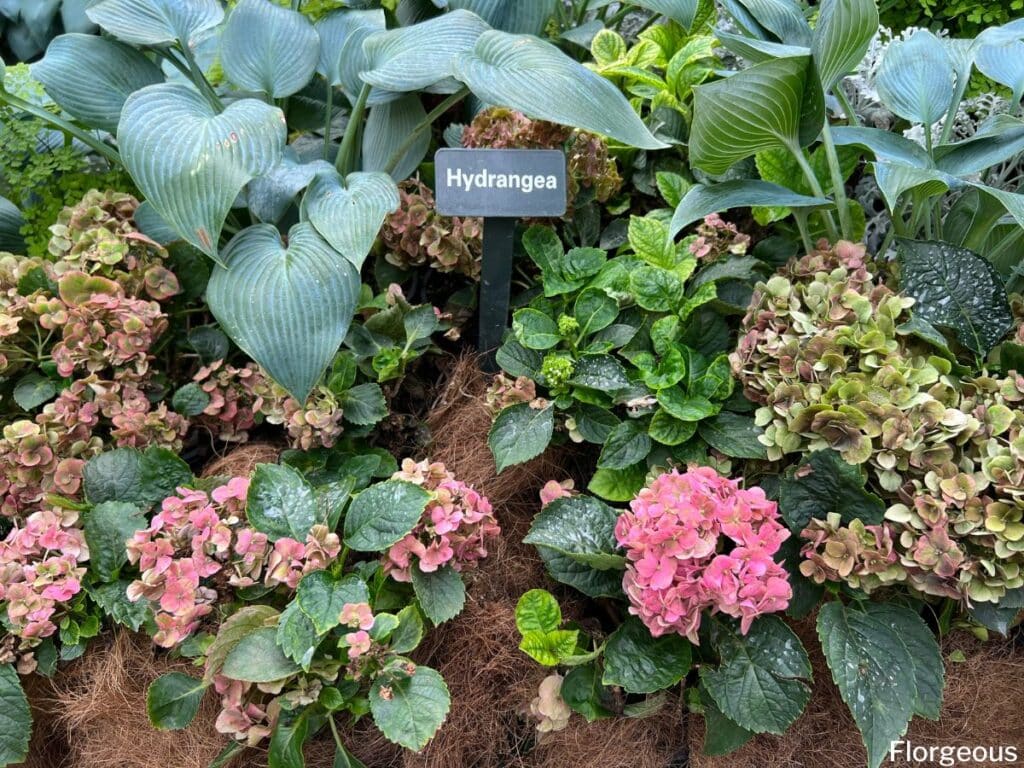
Many gardeners love the idea of landscaping with hydrangeas and hostas.
Hydrangeas (Hydrangea) are also a good option if you want to add lots of color to your garden. This plant with its dark foliage can form a useful backdrop that will enhance light-tinted hostas in the front.
When hydrangeas bloom they will produce huge clusters of pink, white, blue, violet, purple, or pale pink flowers that can add lots of visual interest to your garden.
These shade-loving plants can handle a little bit of sun but they prefer dappled shade. They also need to be grown in fertile soil that drains properly and these plants will thrive if they are kept moist or watered frequently.
Most hydrangea species are quite tall and can quickly grow 4 – 12 feet tall depending on the variety. It is best to grow these colorful flowers at the back of your garden so they won’t conceal your hostas.
See more: What to plant next to hydrangea
Coral Bells

Coral bells (Heuchera), also known as alumroot, are often seen in shade gardens and are very popular front yard hosta companion plants because their colorful foliage will add lots of interest to your garden.
Coral bells come in a variety of foliage colors like green, chartreuse, shiny burgundy, chocolate brown, yellow, peach, pinkish-red, copper, purple, and more. They also produce striking flowers on tall spikes which will add lots of charm when the midsummer flowers start to appear.
These leafy plants will grow well in your hosta garden because they prefer partial shade and can grow well in rich soils that drain well and that are kept moist. These shrubs can survive spells of drought but prefer moist soil at all times.
The vivid foliage plants are terrific companion plants for hostas because they only grow up to 16 inches tall and won’t overpower the other plants in the same bed.
You can mix this evergreen plant with your hostas to add some color to your garden or use them as a garden border so you can create contrast between your lawn and the green hostas.
See more: Heuchera companion plants
Japanese Painted Fern
Japanese painted fern (Athyrium niponicum), also known as lady fern or female fern, is a good option for your shade garden if you want to add some color and texture. These ferns with their soft and feathery leaves with their silvery color will look rather striking if they peek out amongst the dark green hostas.
Lady ferns are shade-loving perennials that will grow well next to your hostas because they require well-draining soil that contains lots of nutrients. The ferns can grow well in partial shade but they can also survive in full shade. They won’t tolerate dry conditions and need to be kept moist throughout the year.
These delicate leafy plants will only grow up to 18 inches tall which means you can easily plant them amongst your other shade-tolerant plants. The lovely foliage won’t overpower the other plants in your garden and can be very helpful garden fillers.
Dogwood
Dogwoods (Cornus) are woody perennial plants that you will often find in hosta gardens.
There are about 60 different species of this shrub and they are mostly known for their beautiful flowers, bright berries, and the charming look that species like red twig dogwood (Cornus sericea) or yellow twig dogwood (Cornus sericea ‘Flaviramea) can offer when these deciduous plants shed their leaves during winter.
Dogwoods will grow well in partial shade to sunny spots in your garden but they rely on moist soil or they can wilt and die.
Some varieties of dogwood like blossoming trees can get rather tall while others will stay in shrub form. Because these bushy plants are taller, it is best to establish them at the back of the garden with your hostas as lovely ground cover in front of or around the base of these trees.
See more: Red twig dogwood companion plants
Astilbes

Astilbe flowers (Astilbe), also known as false goat beard or false spirea, are a good option if you want to add lots of color to your garden. These flowering plants produce lots of delicate flower clusters that will attract hummingbirds.
There are various species that produce soft feathery flowers in vivid colors that range from white, pink, and deep red to violet or lavender when they flower from early to late summer.
Pink spiky astilbes prefer light shade but can also grow in deep shade although this can reduce their blooms. They won’t survive in direct sunlight and require moist damp soil that drains well.
Some varieties of astilbe can grow rather tall with a maximum height of 4 feet tall. When you are pairing them with hostas, you should be careful to place taller astilbe varieties in the back and you can grow the shorter varieties amongst your hosta foliage so those tall spiky flowers can peek out from amongst the dark green foliage all over your hosta bed.
Bleeding Hearts

Bleeding hearts (Lamprocapnos syn. Dicentra) will add lots of color and charm to your garden during spring because they form flowers in the shape of tiny pink hearts. These delicate plants are also available in other colors like pink, white, or red.
Bleeding hearts are also superb perennial plants that go with hostas because they are deer resistant and can help repel these common hosta pests.
These perennial plants are shade lovers but they can grow well in full sun in cold climates. If you establish them in too much sun in warmer regions, the leaves will quickly turn yellow. The flowers need well-drained soil and they need to be kept moist but not too soggy.
Bleeding hearts can grow up to 4 feet tall and can be grown amongst your hosta plants as long as you leave plenty of room for air circulation. Many gardeners prefer to position them in the back so the hosta leaves can conceal these bushes when they die back during winter.
Begonias
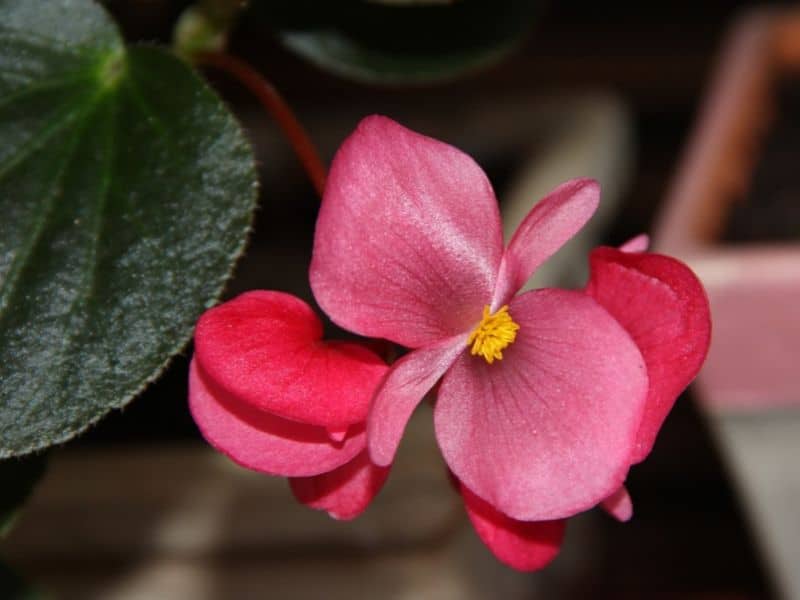
Begonia flowers (Begonia) are great companions for hostas and any other shade-loving plant. There are over 2,000 different species of this flowering plant and you can get varieties in just about any color under the sun.
These shade-loving shrubs will add lots of color to your garden because they produce vivid blooms when they flower from summer to late fall.
Begonias prefer to be established in a sheltered position and they need well-draining but moist soil. They can grow in indirect sun but won’t flower if they don’t receive enough indirect light.
Most begonia varieties have a very similar growing height to hostas. Taller varieties can be established amongst your hostas while shorter varieties can be placed as borders in the front.
When they produce midsummer flowers it will create such a welcome sight in a garden that sometimes looks just a bit too green.
Coleus Plants
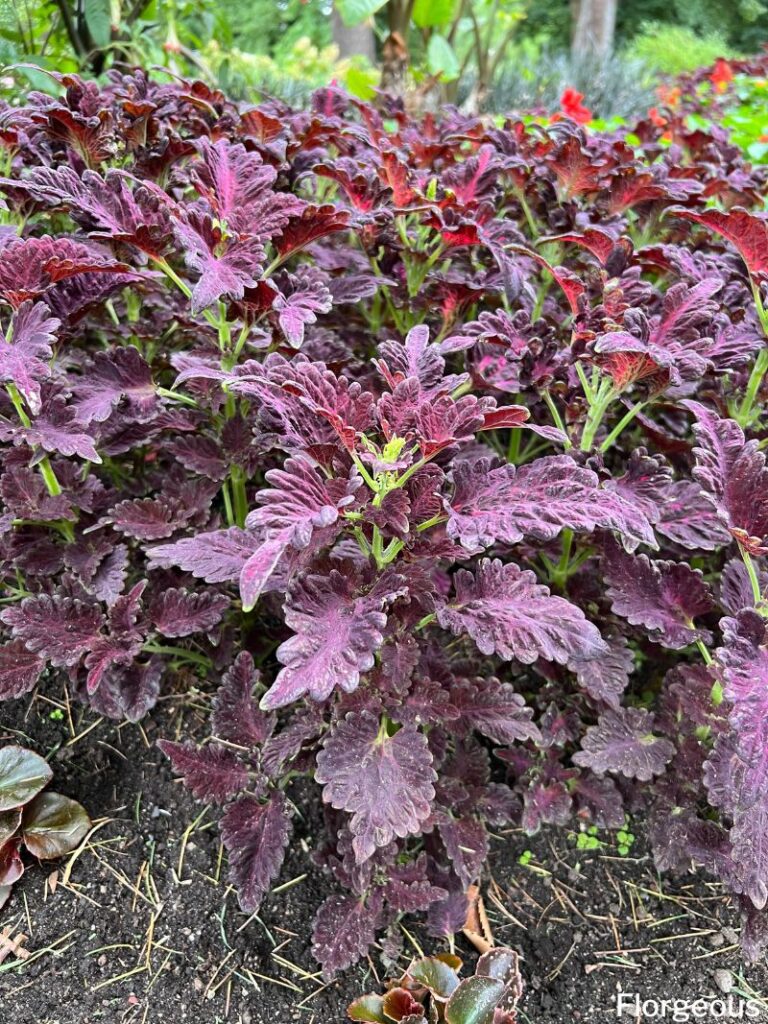
Coleus plants (Coleus scutellarioides) are some of the best companion plants to consider if you want to add lots of color to your garden. This plant produces colorful foliage with lime green exteriors and vibrant red centers. The colorful foliage can, however, vary for different subspecies and there are many varieties that you can pair for an interesting look.
This lovely foliage can grow well in a sunny spot but will survive in partial shade. It needs to e established in well-draining soil that is kept moist.
Coleus flowers can be grown behind your hostas because they can reach a height of up to 3 feet. If you don’t mind a little bit of extra maintenance then you can also grow this shrub amongst our hostas and trim it into a shape to add more structure to your garden.
Foamflower
Foamflowers (Tiarella) are easy-to-grow flowers that pair well with hostas and they will add year-round interest to your garden. From early spring to late fall, these plants will produce white flowers on tall spikes that can add lots of visual interest.
When the flowers start to die back, the lobed leaves with their heart shape will add lots of interest and texture to your garden bed.
Foam flowers prefer moist locations but they can survive shorts spell of drought. These delicate flowers can grow well in full shade but they will also grow well in areas where they receive lots of indirect light.
Some of these species are clump-forming while others are trailing or spreading. Either one of these can be paired with hostas.
If you are adding trailing and spreading varieties to your garden, you should be careful to keep them from smothering your hosta plants too much because hostas require lots of air circulation to flourish.
In mass planting, the foamflower plants will look rather striking when they produce lots of frothy white flowers all over your garden bed.
Siberian Bugloss
Siberian Bugloss (Brunnera), also known as the Queen of Hearts, is superb for perking up shady garden areas because these plants with their heart-shaped leaves come in various foliage colors like green, gold, silver, or even white foliage.
These plants also produce tiny blue flowers that look like forget-me-nots when they bloom in spring. The plants are useful as garden fillers, and groundcovers and can be used as a shade border for the other plants in your garden bed.
Siberian bugloss prefers partial to full shade in areas with good drainage and they need to be established in rich soil that is kept moist.
Because these plants only grow up to 12 inches tall, you can easily pair them with most hosta plants and you can use them in the front of your garden bed or as ground covers to keep the soil around hostas cool and moist.
Caladiums
Caladiums (Caladium) are good companion plants for hostas if you want to add more color to your garden. These plants produce heart-shaped leaves in a variety of colors and patterns.
Colorful foliage varieties are very useful for highlighting darker areas in your garden or for adding more contrast to your hosta beds.
These tropical plants prefer warm climates and can grow well in humid shady areas. They will flourish in moist well-draining soil but can survive in sunny spots.
Most species of caladium can produce large heart-shaped leaves and they are rather tall with a height of up to 30 inches.
You can establish these plants in the back of your garden or grow them in the center with lots of hostas all around them.
Both caladiums and hostas can grow well in containers. If you want to create striking container plants for a front porch then you can add lots of tall caladiums as thriller plants with vivid hostas around them as filler plants.
Add a couple of vine varieties as a spiller and you will have show-stopping container plants that are bound to perk up any front porch.
Daylily

It’s common to see companion plants landscaping with hostas and daylilies in local parks and gardens.
Daylilies, with their spiky leaves and colorful flowers, make an excellent Hosta companion plant when planted in partial shade.
However, because daylily plants require at least six hours of direct sunlight per day for optimal growth, they will not bloom well if the chosen area is too shady.
Daylilies are available in a variety of colors, including white, red, pink, orange, yellow, and purple. When the hostas and daylilies are combined, they will undoubtedly form a lovely border along a path or along the edge of a retaining wall.
Furthermore, some plants to combine with daylilies to create a colorful border include lavender, echinacea, black-eyed Susan and shasta daisy.
What NOT to Plant with Hostas
Hostas can be paired with a great many plant species. But not all plants will grow well in the same shade and moist conditions that these plants need in order to flourish. Some plant combinations might also not look too attractive alongside hostas.
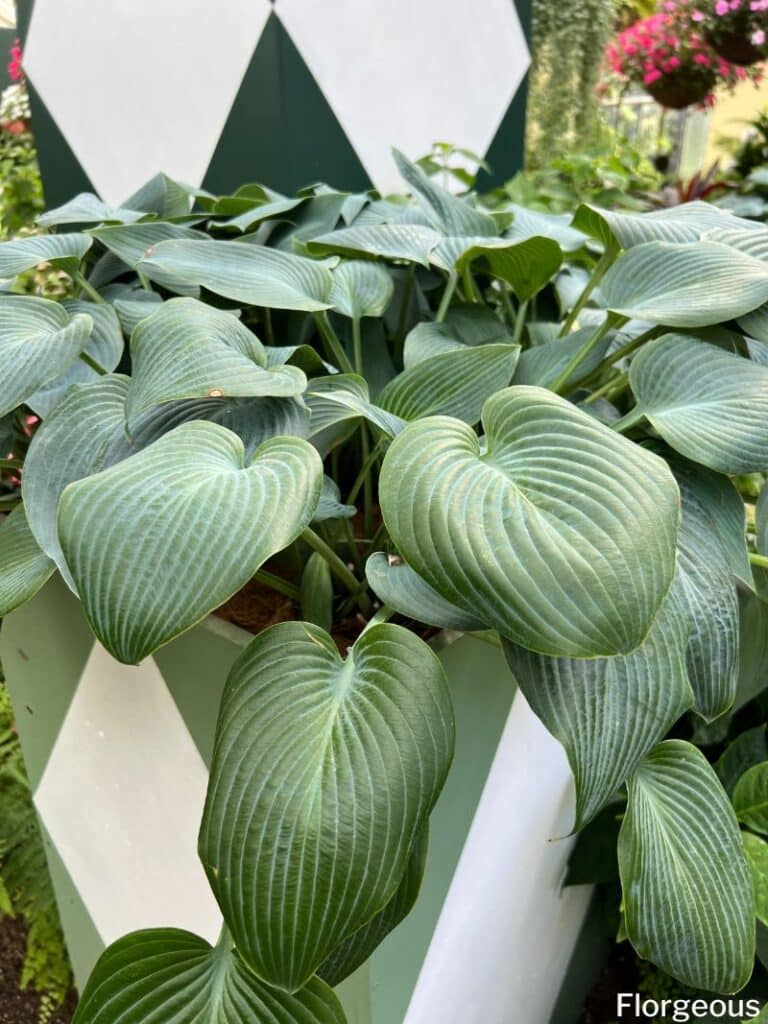
Let’s take a quick look at some plant combinations that you should avoid when you are growing hostas.
Sun-Loving Plants
Hostas are shade-loving perennials that cannot tolerate too much direct sun. They can grow well in areas where they might receive a little bit of morning sun but their leaves can become scorched in hot weather.
Sun-loving plants, on the other hand, won’t grow well and won’t develop flowers if you establish them in a shade garden.
It is best not to grow sun-loving plants like lavender, marigolds, coneflowers, perennial herbs, or dusty miller next to hostas, especially the dark green foliage varieties.
Drought Tolerant Plants
Hostas can survive dry spells but they grow at their best when their roots are kept cool and moist. Drought-resistant plants tend to develop root problems like root rot when they are grown in damp and humid conditions.
To avoid death amongst your hosta plants, it is best not to add companion plants like succulents, weeping love grass, catmint, lavender, or poppies in your shade garden.
FAQs
What grows nicely with hostas?
Hostas pair well with various companion plants such as ferns, heucheras, astilbes, and bleeding hearts. These combinations provide a visually appealing and diverse display in shade gardens.
Do hostas multiply quickly?
Yes, Hostas are known for their ability to multiply and form clumps over time. The rate of multiplication can vary depending on the specific hosta variety, growing conditions, and care provided.
Where best to plant hostas?
Hostas thrive in shaded to partially shaded areas with well-draining soil. They are particularly well-suited for woodland gardens, along borders, or as a ground cover. Choose a location with indirect sunlight, especially in the hotter regions, and ensure the soil is consistently moist. Applying a layer of organic mulch around hostas helps retain moisture and suppress weeds.
Final Thoughts
Hostas are some of the best plants to add to a shade garden. These leafy green plants look charming in mass planting and they can easily survive in limited lighting conditions. They also grow well alongside many companion plants like ferns, begonias, foamflowers, coleus plants, hydrangeas, astilbe, and many others.
We hope that this guide made it a little bit easier to select the best shade shrubs to grow next to your hostas. And if you are also adding other plants to your garden beds then we welcome you to have a look at some of our other companion planting guides. With these guides, you can make the best plant pairing decisions so you can create a great-looking shade garden where everything flourishes and grows well.

